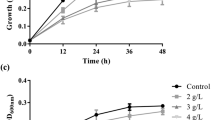Abstract
Optimization of ethanol production through addition of substratum and protein-lipid additives was studied. Oilseed meal extract was used as protein lipid supplement, while rice husk was used as substratum. The effect of oil seed meal extract and rice husk was observed at varying concentration of medium sugar from 8% to 20%. Of the three oil seed meal extracts used, viz. groundnut, safflower, and sunflower, safflower was found to be most efficient. The use of oilseed meal extract at 4% was found to enhance ethanol production by almost 50% and enhanced sugar tolerance from 8% to 16%. A further increase of almost 48% ethanol was observed on addition of 2 g of rice husk per 100 ml of medium. An increase in cell mass with better sugar attenuation was observed. Further optimization was sought through use of sugarcane juice as the sugar source. While 8.9% ethanol yield with 75% sugar attenuation was observed at 20% sucrose concentration, it was found to increase to 12% (v/v) with almost complete utilization of medium sugar when sugarcane juice was used. Cell weight was also observed to increase by 26%.





Similar content being viewed by others
References
Thomas, K. C., Hynes, S. H., & Ingledew, W. M. (1994). Effects of particulate materials and osmoprotectants on very-high-gravity ethanolic fermentation by Saccharomyces cerevisiae. Applied and Environmental Microbiology, 60, 1519–1524.
Casey, G. P., Magnus, C. A., & Ingledew, W. M. (1984). High-gravity brewing: effects of nutrition on yeast composition, fermentative ability, and alcohol production. Applied and Environmental Microbiology, 48, 639–646.
Leluce, C., Tognolli, J. O., De Oliviera, K. F., Souza, C. S., & Morais, M. R. (2009). Optimization of temperature, sugar concentration, inoculum size to maximize ethanol production without significant decrease in yeast viability. Applied Microbiology and Biotechnology, 83, 627–637.
Ding, J., Huang, X., Zhang, L., Zhao, N., Yang, D., & Zhang, K. (2009). Tolerance and stress response to ethanol in the yeast Saccharomyces cerevisiae. Applied Microbiology and Biotechnology, 85, 253–263.
Bai, F. W., Anderson, W. A., & Moo-Young, M. (2008). Ethanol fermentation technologies from sugar and starch feedstocks. Biotechnology Advances, 26, 89–105.
Sankh, S. N., & Arvindekar, A. U. (2004). Availability of substratum enhances ethanol production in Saccharomyces cerevisiae. Biotechnological Letters, 26, 1821–1824.
Bennett, S. W., Tellinghuisen, J. B., & Phillips, L. F. (1971). Absorption coefficients and ionization yields of some small molecules at 58.4 nm. Journal of Physical Chemistry, 75, 719–721.
Choi, G.-W., Kang, H.-W., & Moon, S.-K. (2009). Repeated-batch fermentation using flocculent hybrid, Saccharomyces cerevisiae CHFY0321 for efficient production of bioethanol. Applied Microbiology and Biotechnology, 84, 261–269.
Saigal, D., & Viswanathan, L. (1984). Effect of oils and fatty acids on molasses fermentation by distillers yeast. Enzyme and Microbial Technology, l6, 78–80.
Thomas, K. C., & Ingledew, W. M. (1992). Production of 21% (v/v) ethanol by fermentation of very high gravity (VHG) wheat mashes. Journal of Industrial Microbiology & Biotechnology, 10, 61–68.
Damiano, D., & Wang, S. S. (1985). Improvements in ethanol concentration and fermentor ethanol productivity in yeast fermentations using whole soy floor in batch and continuous recycle systems. Biotechnological Letters, 2, 135–140.
Hayashida, S., Feng, D. D., & Hongo, M. (1974). Function of high concentration alcohol-production factor. Agricultural and Biological Chemistry, 28, 2001–2006.
Kirsop, B. H. (1982). Developments in beer fermentation. Topics in Enzyme and Fermentation Biotechnology, 6, 79–131.
Reddy, L. V. A., & Reddy, O. V. S. (2005). Improvement of ethanol production in very high gravity fermentation by horse gram (Dolichos biflorus) flour supplementation. Letters in Applied Microbiology, 41, 440–444.
Bafrncova, P., Smogrovicova, D., Slavikova, I., Patkova, J., & Domeny, Z. (1999). Improvement of very high gravity ethanol fermentation by media supplementation using Saccharomyces cerevisiae. Biotechnological Letters, 21, 337–341.
Delic, I., Levic, J., & Sredanovic, S. (1992). Standard and improved sunflower meal containing 44% crude protein -production, chemical composition, nutritive value. Savetovanje proizvodnja i prerada uljarica, 33, 268–287.
Nagastu, A. (2004). Investigation of antioxidative compounds from oil plant seed. FABAD J Pharm Sci., 29, 203–210.
You, K. M., Rosenfield, C.-L., & Knipple, D. C. (2003). Ethanol tolerance in the yeast Saccharomyces cerevisiae is dependent on cellular oleic acid content. Applied and Environmental Microbiology, 69, 1499–1503.
Kuhbeck, F., Muller, M., Back, W., Kurz, T., & Krottenthaler, M. (2007). Effect of hot trub and particle addition on fermentation performance of Saccharomyces cerevisiae. Enzyme and Microbial Technology, 41, 711–720.
Liang, L., Zhang, Y. P., Zhang, L., Zhu, M. J., Liang, S. Z., & Huang, Y. N. (2008). Study of sugarcane pieces as yeast supports for ethanol production from sugarcane juice and molasses. Journal of Industrial Microbiology & Biotechnology, 35, 1605–1613.
Laopaiboon, L., Nuanpeng, S., Srinophakun, P., Klanrit, P., & Laopaiboon, P. (2009). Ethanol production from sweet sorghum juice using very high gravity technology: effects of carbon and nitrogen supplementations. Bioresource Technology, 100, 4176–4418.
Author information
Authors and Affiliations
Corresponding author
Rights and permissions
About this article
Cite this article
Sankh, S.N., Deshpande, P.S. & Arvindekar, A.U. Improvement of Ethanol Production Using Saccharomyces cerevisiae by Enhancement of Biomass and Nutrient Supplementation. Appl Biochem Biotechnol 164, 1237–1245 (2011). https://doi.org/10.1007/s12010-011-9209-z
Received:
Accepted:
Published:
Issue Date:
DOI: https://doi.org/10.1007/s12010-011-9209-z




